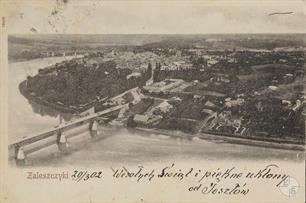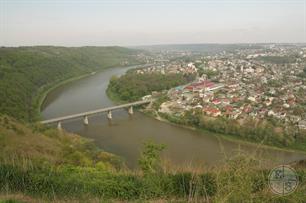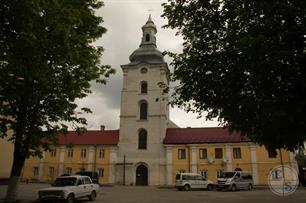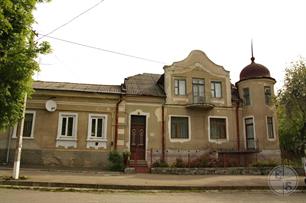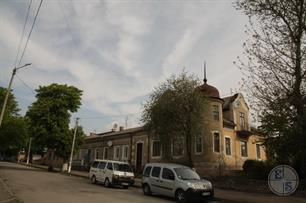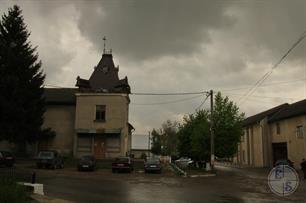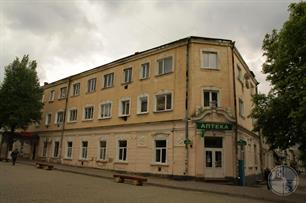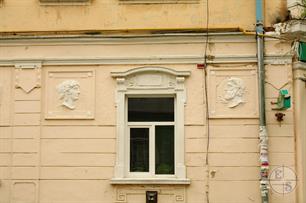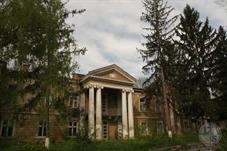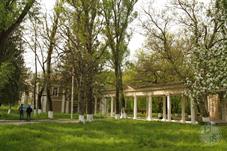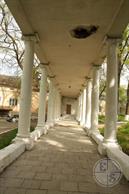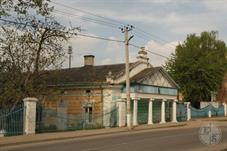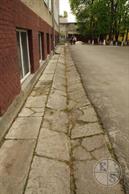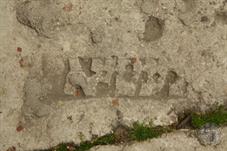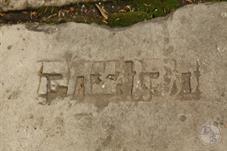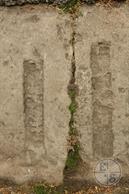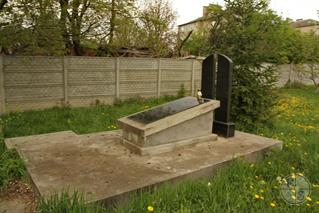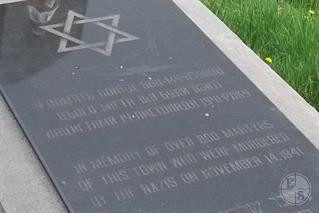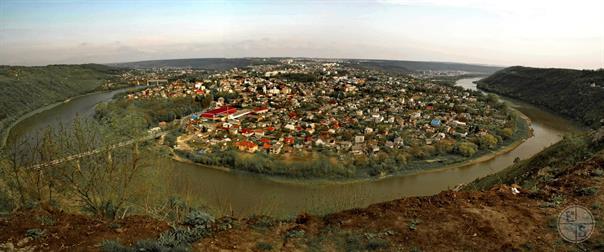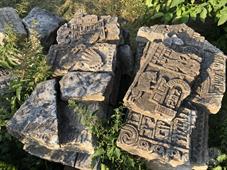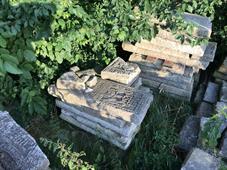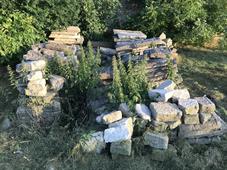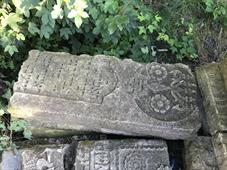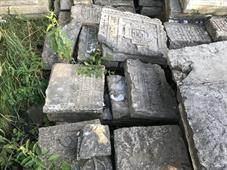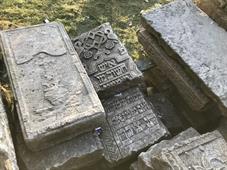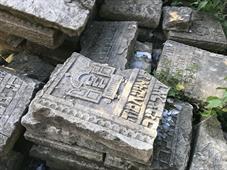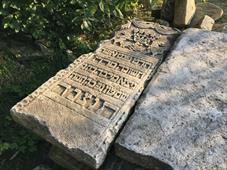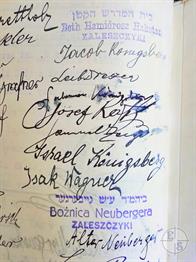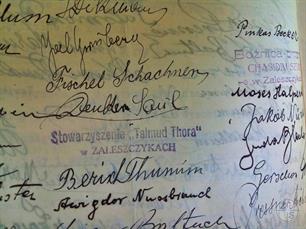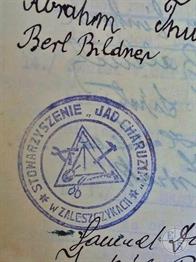Zalishchyky
Ternopil region
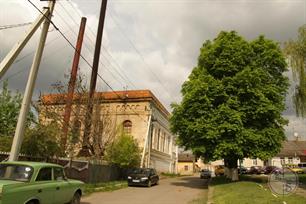 |
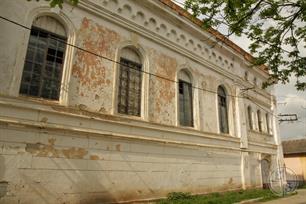 |
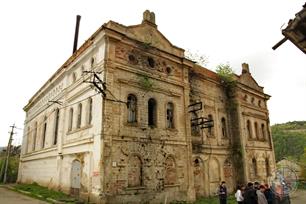 |
| The former synagogue in Zalishchyky | ||
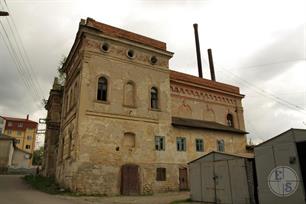 |
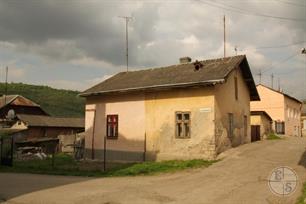 |
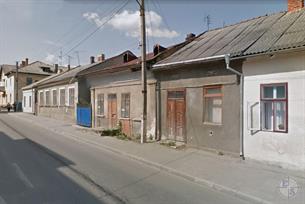 |
| Jewish house near the synagogue | Former Jewish houses on Makovey Street |
Zalishchyky (ukr. Заліщики) lies on a tributary of the Dneister River and is surrounded by the river on three sides. The river was used to transport lumber from the Carpathian Mountains to Russia and many townspeople, including many Jews, were in the lumber trade. River flooding in 1863, 1871, and 1927 caused considerable damage. The 1871 flood killed about 100 people and destroyed a number of riverside flour mills, with property and material damage estimated at 30,000 crowns.
In the late 19th century, hothouses were established for vegetable farming and vineyards were planted. During the [post-World War I] period of Polish independence, Zalishchyky became a well known resort town which drew thousands of vacationers each year. Located on the Romanian border, it also became a center of illegal entry and smuggling.
Jews appear to have been among the founders of the city. In the late 1700's when Poland was divided and Austrian rule of the region began most Jews were merchants or artisans. The 1772 census lists 159 Jewish families.
In the late 19th century, hothouses were established for vegetable farming and vineyards were planted. During the [post-World War I] period of Polish independence, Zalishchyky became a well known resort town which drew thousands of vacationers each year. Located on the Romanian border, it also became a center of illegal entry and smuggling.
Jews appear to have been among the founders of the city. In the late 1700's when Poland was divided and Austrian rule of the region began most Jews were merchants or artisans. The 1772 census lists 159 Jewish families.
In 1787, the government helped 50 Jews establish farms in the vicinity of Zalishchyky, but these farms were short-lived.
In the 19th century, especially the second half, Jews became increasingly involved in the trades. They were involved in all areas of commerce, competing with non-Jewish merchants as well as with one another.
In 1863, when a Jewish manufacturer sought to collect a loan to a Christian storekeeper, the storekeeper incited the town's gentiles against the Jews. In the small riot which ensued, Jews were beaten and Jewish property was destroyed. Only the intervention of the Chernovitz police could halt the riot. That year also saw the murder of a Jewish family in a nearby hamlet.
In the 1890's, an economic downturn and increased competition with non-Jews led many Jews to emigrate to the United States. The Hilfsverein in Vienna assisted Zalishchyky's Jews. But, of 123 young women employed in the workshops it established, all but 35 left the work due to low wages.
At the start of the 20th century a Jewish loan association was established in Zalishchyky.
In the 19th century, especially the second half, Jews became increasingly involved in the trades. They were involved in all areas of commerce, competing with non-Jewish merchants as well as with one another.
In 1863, when a Jewish manufacturer sought to collect a loan to a Christian storekeeper, the storekeeper incited the town's gentiles against the Jews. In the small riot which ensued, Jews were beaten and Jewish property was destroyed. Only the intervention of the Chernovitz police could halt the riot. That year also saw the murder of a Jewish family in a nearby hamlet.
In the 1890's, an economic downturn and increased competition with non-Jews led many Jews to emigrate to the United States. The Hilfsverein in Vienna assisted Zalishchyky's Jews. But, of 123 young women employed in the workshops it established, all but 35 left the work due to low wages.
At the start of the 20th century a Jewish loan association was established in Zalishchyky.
An organized Jewish community existed in Zalishchyky from the end of the 18th century. At first, it appears to have been subsidiary to the community of Tluste, and used its cemetery. In the early 1800's, a Jewish cemetery was consecrated in Zalishchyky and a synagogue was built. This synagogue, four smaller prayer houses, and 170 homes were destroyed in a major fire in 1871. It was reconstructed with the help of Baron Rothschild and the local mayor.
R. Samuel, the son of R. Isaac Dov Margolis, was Zalishchyky's first rabbi. He had previously served as the rabbi of Jaslowiec [Pomortsy] and, according to tradition, was a disciple of the Baal Shem Tov. In the 1860's the rabbi was R. Arieh Yuda Leibush Igra, who died in 1870. He was succeeded by R. Menachem Arieh Zeismer (Reichenberg), son of R. Solomon Naftali, author of MeAyin Arieh..
In the 1880's, after Reb Menachem went to Cracow to serve as a Hasidic rebbe for the down-trodden, the rabbi was R. Abraham Teumim, author of Birchata Avrohom. He was followed in 1896 by his son, R. Zev, author of Anaf Etz Aroth and rabbi of Bucharest from 1891 to 1896, who was to serve the community for almost 50 years.
In the late 19th century, a Hasidic rebbe, Rabbi Shrage Feivush Hager, son of R. Baruch, settled in Zaleshchiki. The Hasidim in Zalishchyky were followers of either the Rizhin dynasty (especially of the Chortkov branch) or of the Viznitz-Kossov Hasidim.
In the early 1900's, a wealthy and educated Jew, Chaim Shmuel, son of Meir Yehuda Glass, established a printing press in Zalishchyky, hoping to publish religious works. The only book printed was a collection of his own sermons Imre Shoffer ("Fine Sayings").
R. Samuel, the son of R. Isaac Dov Margolis, was Zalishchyky's first rabbi. He had previously served as the rabbi of Jaslowiec [Pomortsy] and, according to tradition, was a disciple of the Baal Shem Tov. In the 1860's the rabbi was R. Arieh Yuda Leibush Igra, who died in 1870. He was succeeded by R. Menachem Arieh Zeismer (Reichenberg), son of R. Solomon Naftali, author of MeAyin Arieh..
In the 1880's, after Reb Menachem went to Cracow to serve as a Hasidic rebbe for the down-trodden, the rabbi was R. Abraham Teumim, author of Birchata Avrohom. He was followed in 1896 by his son, R. Zev, author of Anaf Etz Aroth and rabbi of Bucharest from 1891 to 1896, who was to serve the community for almost 50 years.
In the late 19th century, a Hasidic rebbe, Rabbi Shrage Feivush Hager, son of R. Baruch, settled in Zaleshchiki. The Hasidim in Zalishchyky were followers of either the Rizhin dynasty (especially of the Chortkov branch) or of the Viznitz-Kossov Hasidim.
In the early 1900's, a wealthy and educated Jew, Chaim Shmuel, son of Meir Yehuda Glass, established a printing press in Zalishchyky, hoping to publish religious works. The only book printed was a collection of his own sermons Imre Shoffer ("Fine Sayings").
The end of the war found Zalishchyky's Jews in bad financial straits. The war had left many widows and orphans, and many of the able-bodied men could not get work. About 2,000 of the town's 2,485 Jews received aid from the Joint Distribution Committee and from landsleit in the United States.
However, Zalishchyky's rise as a resort area helped many Jews. In 1930, 4,105 people vacationed there, in 1931, 5,315, and in 1932, more than 8,000. Jews were involved in food services (some food was purchased in Romania), room rentals, and other services.
In 1927, the Dneister flooded, leaving many homes in Zalishchyky under water. Many monuments and
fences in the Jewish cemetery were badly damaged. The Greek Orthodox Metropolitan in Lvov, Archbishop A. Sheptizky, raised $10,000 to help Zalishchyky's Ukrainian settlers, but assistance for the Jews from Jewish relief organizations in Poland or from their compatriots in the United States was less forthcoming.
From 1928 to 1930, the Jews' financial plight worsened because of the depression and increased competition from Ukrainians and Polish cooperatives. In 1932 the Jewish community collected 1.6 zl. per Jew -3,850 zlotys in total - a very low figure.
Jewish craftsmen formed B'yad Charuzim, a mutual assistance group, in the 1920's, and in 1931 the merchants and manufacturers their own aid association. Together, these groups established a free loan society, and an association to give larger loans with interest. The free loan society received 8,325 zlotys in aid from the Joint. In 1930 it granted 408 free loans worth 64,129 zlotys. In 1936-37, 182 small merchants, 133 craftsmen and 14 workers (?) received loans.
However, Zalishchyky's rise as a resort area helped many Jews. In 1930, 4,105 people vacationed there, in 1931, 5,315, and in 1932, more than 8,000. Jews were involved in food services (some food was purchased in Romania), room rentals, and other services.
In 1927, the Dneister flooded, leaving many homes in Zalishchyky under water. Many monuments and
fences in the Jewish cemetery were badly damaged. The Greek Orthodox Metropolitan in Lvov, Archbishop A. Sheptizky, raised $10,000 to help Zalishchyky's Ukrainian settlers, but assistance for the Jews from Jewish relief organizations in Poland or from their compatriots in the United States was less forthcoming.
From 1928 to 1930, the Jews' financial plight worsened because of the depression and increased competition from Ukrainians and Polish cooperatives. In 1932 the Jewish community collected 1.6 zl. per Jew -3,850 zlotys in total - a very low figure.
Jewish craftsmen formed B'yad Charuzim, a mutual assistance group, in the 1920's, and in 1931 the merchants and manufacturers their own aid association. Together, these groups established a free loan society, and an association to give larger loans with interest. The free loan society received 8,325 zlotys in aid from the Joint. In 1930 it granted 408 free loans worth 64,129 zlotys. In 1936-37, 182 small merchants, 133 craftsmen and 14 workers (?) received loans.
When the Soviets ruled Zalishchyky - September 1939 to June 1941 - all official Jewish activities ceased. However, many Jewish students attended the Yiddish school which was established , and unofficial religious services were organized. Before Passover 1940, a flour mill was koshered without government knowledge to provide flour for matzo. The official in charge of the project was arrested and detained.
Under the Soviets, all private shops were closed, factories and workshops were nationalized, and artisans were forced to form cooperatives. A group of Jewish communists held key positions in the new regime. When the war with Germany broke out, a small number of Jews - mainly Jewish communist activists - fled to the USSR. Scared of revenge by the Germans and Ukrainian nationalists, they fled to Chernowitz to hide.
The Germans captured Zalishchyky on July 8, 1941, and immediately began to persecute the Jews. Jews subjected to various economic and other decrees, and to a curfew. Dr. Michael Kutner was made head of the Judenrat in July 1941. In September, the Jews were ordered to supply three kilos of gold, silver, and other valuables to the Germans.
In fall 1941 a group of young Jews were taken for slave labor in the Zhvanets camp near Zalishchyky. On November 14, the Germans ordered all Jewish men aged 15 to 50 to assemble, reportedly to register and for some to be sent to Kamionka to work. Some skeptical Jews hid; about 1,000 assembled. The Germans sent 200 to the Kamionka labor camp; about 40 others, including Kutner, were sent to a nearby army camp and forced to dig mass graves. Soon the other 800 were brought there and gunned down.
By winter of 1941-42 conditions had worsened severely. Many Jews died of hunger and typhoid. The Judenrat and other public groups provided assistance and medical care. In spring and summer of 1942, Jews continued to be sent to labor camps in the nearby towns of Rozhnov, Svidova, Lisovitse, Kozia Gora, Holov Anizah. Many of these camps were devoted to the manufacture of synthetic rubber.
On September 20, 1942, the Germans expelled Zalishchyky's Jews to neighboring ghettoes. Most were sent to Tluste; smaller groups were taken to Korolovka, Yagelnitsa, Bucacz, Borshchev, Melnitsa, and Skole. They shared the fate of other Jews in mass murder "Aktions" in spring 1943. Many others were killed in the Belzec death camp.
Two hundred Jews remained in labor battalions. Some tried to save themselves most unsuccessfully by fleeing to Romania, hiding with Christians or in bunkers. By mid-1943, all the Jews had been transferred to work camps in Tluste.
In March 1944, the region was liberated by the Russians. Among the survivors were a few from Zalishchyky. However, the Germans recaptured the area for a few days and killed more Jews, including some from Zalishchyky.
After the city was again liberated on March 24, 1944, a few dozen Jews who had survived by hiding or who returned from the camps gathered there. In mid-1944 others returned from the USSR. However, Jewish life did not take hold and most Jews left Zalishchyky. Some went to Israel via Romania; others went to Poland and then to Israel and other countries.
Under the Soviets, all private shops were closed, factories and workshops were nationalized, and artisans were forced to form cooperatives. A group of Jewish communists held key positions in the new regime. When the war with Germany broke out, a small number of Jews - mainly Jewish communist activists - fled to the USSR. Scared of revenge by the Germans and Ukrainian nationalists, they fled to Chernowitz to hide.
The Germans captured Zalishchyky on July 8, 1941, and immediately began to persecute the Jews. Jews subjected to various economic and other decrees, and to a curfew. Dr. Michael Kutner was made head of the Judenrat in July 1941. In September, the Jews were ordered to supply three kilos of gold, silver, and other valuables to the Germans.
In fall 1941 a group of young Jews were taken for slave labor in the Zhvanets camp near Zalishchyky. On November 14, the Germans ordered all Jewish men aged 15 to 50 to assemble, reportedly to register and for some to be sent to Kamionka to work. Some skeptical Jews hid; about 1,000 assembled. The Germans sent 200 to the Kamionka labor camp; about 40 others, including Kutner, were sent to a nearby army camp and forced to dig mass graves. Soon the other 800 were brought there and gunned down.
By winter of 1941-42 conditions had worsened severely. Many Jews died of hunger and typhoid. The Judenrat and other public groups provided assistance and medical care. In spring and summer of 1942, Jews continued to be sent to labor camps in the nearby towns of Rozhnov, Svidova, Lisovitse, Kozia Gora, Holov Anizah. Many of these camps were devoted to the manufacture of synthetic rubber.
On September 20, 1942, the Germans expelled Zalishchyky's Jews to neighboring ghettoes. Most were sent to Tluste; smaller groups were taken to Korolovka, Yagelnitsa, Bucacz, Borshchev, Melnitsa, and Skole. They shared the fate of other Jews in mass murder "Aktions" in spring 1943. Many others were killed in the Belzec death camp.
Two hundred Jews remained in labor battalions. Some tried to save themselves most unsuccessfully by fleeing to Romania, hiding with Christians or in bunkers. By mid-1943, all the Jews had been transferred to work camps in Tluste.
In March 1944, the region was liberated by the Russians. Among the survivors were a few from Zalishchyky. However, the Germans recaptured the area for a few days and killed more Jews, including some from Zalishchyky.
After the city was again liberated on March 24, 1944, a few dozen Jews who had survived by hiding or who returned from the camps gathered there. In mid-1944 others returned from the USSR. However, Jewish life did not take hold and most Jews left Zalishchyky. Some went to Israel via Romania; others went to Poland and then to Israel and other countries.
Sources:
- Pinkas Hakehillot Polin: Encyclopedia of Jewish Communities, Poland, Volume II, pages 54-55, published by Yad Vashem, Jerusalem. Edited by Renйe Steinig, JewishGen, Inc.
Photo:
- Eugene Shnaider
- Tetiana Fedoriv. Stamps of synagogues
- European Jewish Cemeteries Initiative. Zalishchyky Jewish Cemetery
- The Center for Jewish Art. Site of the Jewish cemetery in Zalishchyky
- Pinkas Hakehillot Polin: Encyclopedia of Jewish Communities, Poland, Volume II, pages 54-55, published by Yad Vashem, Jerusalem. Edited by Renйe Steinig, JewishGen, Inc.
Photo:
- Eugene Shnaider
- Tetiana Fedoriv. Stamps of synagogues
- European Jewish Cemeteries Initiative. Zalishchyky Jewish Cemetery
- The Center for Jewish Art. Site of the Jewish cemetery in Zalishchyky
The first Zionist activity began in the 1890's. In 1897, the "Zion" organization and a woman's group, "Rachel," were founded. At the start of the 20th century, a Poale Zion (Zionist labor) group and a branch of the Jewish labor organization ZPS were established. Einheit ("unity"), created in 1912 to merge the earlier two labor groups, functioned instead as a third group. The Orthodox Jews under the leadership of R. Zev Teumim established a 235 member branch of the Agudath Israel party.
In 1894, the Baron Hirsch fund established a Jewish school, which had 235 pupils. Many Jewish students attended public schools in Zaleshchiki and vicinity. In the early 20th century, seven Jews attended universities. In 1904 a complete Jewish school was established.
In the fall of 1914, the Russians captured Zalishchyky. The following February, Russian soldiers rioted for two days against the towns Jews, and killed or injured 30 of them. On April 17, 1915, Zaleshchiki's Jews were all expelled. Many died of cholera and typhoid. Survivors returned to find their property looted and, in many cases, their homes destroyed.
In 1894, the Baron Hirsch fund established a Jewish school, which had 235 pupils. Many Jewish students attended public schools in Zaleshchiki and vicinity. In the early 20th century, seven Jews attended universities. In 1904 a complete Jewish school was established.
In the fall of 1914, the Russians captured Zalishchyky. The following February, Russian soldiers rioted for two days against the towns Jews, and killed or injured 30 of them. On April 17, 1915, Zaleshchiki's Jews were all expelled. Many died of cholera and typhoid. Survivors returned to find their property looted and, in many cases, their homes destroyed.
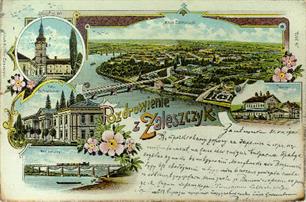 |
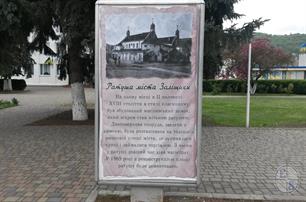 |
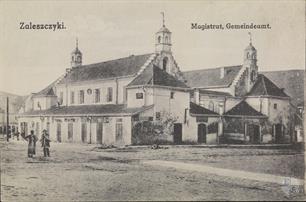 |
| Wonderful Polish postcard. We see the church and the palace of Brunicki | Once there was a town hall | |
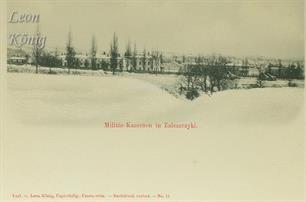 |
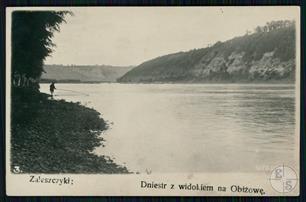 |
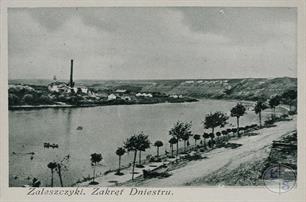 |
| Barracks | And a few landscapes |
In the Sejm elections in 1928 and 1930 most Jews voted for Zionist parties. Active Zionist parties included the General Zionists, the United Zionists, and the Revisionists. The Mizrachi has few supporters in Zalishchyky and was not organized there until 1938. The Bund, an outgrowth of the ZPS, was not a factor in Zalishchyky. Active youth movements included Betar (whose 1934 world congress was held in Zalishchyky), the Noar Ivri, the Noar Zioni, and Gorodonrah.
In local and Jewish community elections many Jews voted for the Orthodox parties, including the influential Agudath Israel and the Hasidic Machzikei Hadaas ("Upholders of the Faith").
In the municipal elections of 1928, 11 of 32 elected councilors were Jews and in 1934 elections, five of 16 (two Zionist, three Agudath Israel). Dr. Michael Kutner, a Zionist, was as a vice mayor and another Jew, apparently from Agudath Israel, served on the town's Executive Council. In 1939 only four Jews were elected - two craftsmen, one Zionist and one merchant. The municipality treated Jews well and allocated them a fair share of municipal and welfare services.
In 1933 the first Jewish community council elections were held. Until then Michael Kutner served as commissioner and was accepted by the government. The Zionists did not contest the elections. The results were: Economic Bloc, 2 seats; Agudath Israel, 2 seats; Machzikei Hadaas, 2; Yad Charuzim, 1; local list, 1. Dr. Rosen, apparently a member of the Economic Bloc, was elected head of the community. In 1938, a united list - based on the 1933 results was proposed and Dr. Rosen was again elected head of the community.
When R. Zev Teumim died in 1931, the two candidates for succession were his son-in-law, , R. Fishel Weinberger of Przemysl, and R. Mordechai Sprecher, a rabbinical judge. Neither was elected and both subsequently served as rabbinical judges.
Welfare activities were run by the official community as well as by private groups. Some years as much as $1,300 was collected from landsleit in the United States. WIZO was active in Zalishchyky, assisting the Jewish sick with kosher hospital meals and with nursing aid at home. WIZO and the community ran the Passover Assistance Fund and served the needy two meals a day in a public kitchen. With the municipality's support, every Jewish child received a roll and a liter of milk daily. Assistance for clothing was nonsectarian. Two Jewish doctors, Adolph Rosen and Michael Rosenbaum, treated the poor at no charge. The Ochronke Jewish Orphanage also served the community.
When the Baron Hirsch school building - appropriated by the municipality to use as a public school was vacant again, the Jewish community decided to establish a "People's Center" there, with lectures, halls, a library, and offices. Remodeled in winter 1938-39, the building was never to fully serve its intended purpose.
In the early 1920's, the Union of Jewish Elementary and High Schools of Lvov established a five-grade Jewish gymnasium--high school which closed in 1927 for financial reasons. Jewish students later studied in the public gymnasium established in the 1930's. In 1939, seven graduates in a class of 19 were Jewish.
The Zionists established a kindergarten, and a Hebrew high school with 160 pupils. Agudath Israel ran the Yesodei HaTorah school. Cultural organizations included a public library, a drama circle, a Maccabbi sports club, and a Maccabbi-sponsored Friday-night lecture series.
In 1926, Jews defended themselves when attacked by Army draftees. Fourteen Jews were arrested, and several received jail sentences. Only four attackers were arrested, and all were released. In 1934 an anti-Semitic Polish play was produced in Zalishchyky and in 1938 a Jewish shopkeeper was killed nearby. However, local officials who mistreated Jews were removed from their positions.
In local and Jewish community elections many Jews voted for the Orthodox parties, including the influential Agudath Israel and the Hasidic Machzikei Hadaas ("Upholders of the Faith").
In the municipal elections of 1928, 11 of 32 elected councilors were Jews and in 1934 elections, five of 16 (two Zionist, three Agudath Israel). Dr. Michael Kutner, a Zionist, was as a vice mayor and another Jew, apparently from Agudath Israel, served on the town's Executive Council. In 1939 only four Jews were elected - two craftsmen, one Zionist and one merchant. The municipality treated Jews well and allocated them a fair share of municipal and welfare services.
In 1933 the first Jewish community council elections were held. Until then Michael Kutner served as commissioner and was accepted by the government. The Zionists did not contest the elections. The results were: Economic Bloc, 2 seats; Agudath Israel, 2 seats; Machzikei Hadaas, 2; Yad Charuzim, 1; local list, 1. Dr. Rosen, apparently a member of the Economic Bloc, was elected head of the community. In 1938, a united list - based on the 1933 results was proposed and Dr. Rosen was again elected head of the community.
When R. Zev Teumim died in 1931, the two candidates for succession were his son-in-law, , R. Fishel Weinberger of Przemysl, and R. Mordechai Sprecher, a rabbinical judge. Neither was elected and both subsequently served as rabbinical judges.
Welfare activities were run by the official community as well as by private groups. Some years as much as $1,300 was collected from landsleit in the United States. WIZO was active in Zalishchyky, assisting the Jewish sick with kosher hospital meals and with nursing aid at home. WIZO and the community ran the Passover Assistance Fund and served the needy two meals a day in a public kitchen. With the municipality's support, every Jewish child received a roll and a liter of milk daily. Assistance for clothing was nonsectarian. Two Jewish doctors, Adolph Rosen and Michael Rosenbaum, treated the poor at no charge. The Ochronke Jewish Orphanage also served the community.
When the Baron Hirsch school building - appropriated by the municipality to use as a public school was vacant again, the Jewish community decided to establish a "People's Center" there, with lectures, halls, a library, and offices. Remodeled in winter 1938-39, the building was never to fully serve its intended purpose.
In the early 1920's, the Union of Jewish Elementary and High Schools of Lvov established a five-grade Jewish gymnasium--high school which closed in 1927 for financial reasons. Jewish students later studied in the public gymnasium established in the 1930's. In 1939, seven graduates in a class of 19 were Jewish.
The Zionists established a kindergarten, and a Hebrew high school with 160 pupils. Agudath Israel ran the Yesodei HaTorah school. Cultural organizations included a public library, a drama circle, a Maccabbi sports club, and a Maccabbi-sponsored Friday-night lecture series.
In 1926, Jews defended themselves when attacked by Army draftees. Fourteen Jews were arrested, and several received jail sentences. Only four attackers were arrested, and all were released. In 1934 an anti-Semitic Polish play was produced in Zalishchyky and in 1938 a Jewish shopkeeper was killed nearby. However, local officials who mistreated Jews were removed from their positions.

- Home
- Shtetls
- Vinnytsia region
- Volyn region
- Dnipro region
- Donetsk region
- Zhytomyr region
- Zakarpattia region
- Zaporizhzhia region
- Ivano-Frankivsk region
- Kyiv region
- Kropyvnytskyi region
- Luhansk region
- Lviv region
- Mykolayiv region
- Odessa region
- Poltava region
- Rivne region
- Sumy region
- Ternopil region
- Kharkiv region
- Kherson region
- Khmelnytskyi region
- Chernihiv region
- Chernivtsi region
- Cherkasy region
- Crimea
- Synagogues
- Cemeteries
- Objects & guides
- Gallery
- History
- Contact
Jewish towns of Ukraine
Jewish towns of Ukraine
My shtetl
My shtetl
Donate
